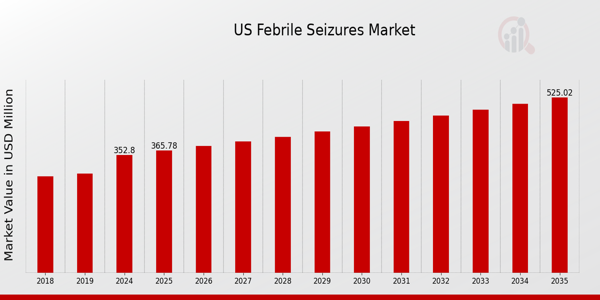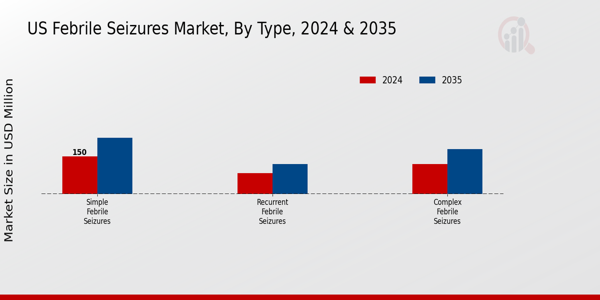US Febrile Seizures Market Overview
As per MRFR analysis, the US Febrile Seizures Market Size was estimated at 340.2 (USD Million) in 2023.The US Febrile Seizures Market Industry is expected to grow from 352.8 (USD Million) in 2024 to 525 (USD Million) by 2035. The US Febrile Seizures Market CAGR (growth rate) is expected to be around 3.68% during the forecast period (2025 - 2035).
Key US Febrile Seizures Market Trends Highlighted
The US Febrile Seizures Market is experiencing notable trends driven by an increasing awareness of febrile seizures among parents and healthcare professionals. As more parents educate themselves about the phenomenon and symptoms of febrile seizures, there is heightened demand for effective management solutions. The growing focus on early diagnosis and intervention also plays a key role, as healthcare providers recommend comprehensive education and support for families dealing with this condition. Furthermore, advancements in medical technology and research have led to the development of new therapeutic options, enhancing treatment efficacy and safety for affected children.
The US febrile seizures market is expanding as new innovations focused on young patients are being developed by pharmaceutical companies and medical device manufacturers. Companies that target pediatric primary care will greatly benefit from these proactive marketing approaches, such as creating powerful educational resources that aid parents in understanding the causes and management of febrile seizures. Recent trends indicate a shift towards comprehensive educational and lifestyle-driven management solutions that integrate pharmacological and non-pharmacological elements.
With the support of healthcare professionals, parents are encouraged to engage more actively in the care of their children, fostering an environment that helps reduce the incidence of febrile seizures. This collaborative approach is reflective of the changing landscape of pediatric healthcare in the US, where emphasis is placed on comprehensive solutions that prioritize family involvement, knowledge sharing, and ongoing community support.

Source: Primary Research, Secondary Research, MRFR Database, and Analyst Review
US Febrile Seizures Market Drivers
Increasing Incidence of Febrile Seizures among Children
The US Febrile Seizures Market Industry is driven by the rising incidence of febrile seizures, particularly among children aged six months to five years. According to the National Institutes of Health, febrile seizures occur in approximately 2-5% of children, with around 100,000 cases reported annually in the United States. This increasing prevalence is often correlated with viral infections, such as the recent resurgence of respiratory syncytial virus (RSV) and influenza, which have led to higher hospital visits.
The American Academy of Pediatrics and various child health organizations emphasize the importance of awareness and treatment options for febrile seizures, thus driving the market for related medical products and interventions.
Advancements in Medical Technology and Treatments
The growth of the US Febrile Seizures Market Industry is significantly influenced by advancements in medical technology and treatments. Innovative monitoring devices and therapeutic options, including antipyretic medications and the development of new vaccines, aimed at preventing infections that can lead to febrile seizures, have seen increased investment. According to the Centers for Disease Control and Prevention, the introduction of new vaccines in recent years has contributed to a decline in preventable diseases that can cause fevers and subsequent seizures, which encourages the development of new products in the market.
Increased Awareness and Education Initiatives
In the US, increased awareness surrounding febrile seizures among parents and healthcare providers serves as a catalyst for the growth of the US Febrile Seizures Market Industry. Educational campaigns led by institutions like the Epilepsy Foundation have reached millions, improving the understanding of febrile seizures, their causes, and management strategies. This heightened awareness is critical, as studies indicate that early medical intervention reduces anxiety and fear among parents, leading to more frequent consultations with healthcare professionals.
Consequently, this trend promotes higher demand for medical treatments and resources aimed at managing febrile seizures.
US Febrile Seizures Market Segment Insights
Febrile Seizures Market Type Insights
The US Febrile Seizures Market exhibits significant segmentation by type, focusing mainly on Simple Febrile Seizures, Complex Febrile Seizures, and Recurrent Febrile Seizures. Simple Febrile Seizures are the most common type, typically characterized by their brief duration and the absence of underlying neurological concerns, making them crucial in informing treatment protocols for pediatric patients who experience fevers. Their relatively benign nature contributes to a high patient recovery rate and has established a robust foundation for parental education on febrile seizure management.
The prevalence of Simple Febrile Seizures influences numerous healthcare strategies in the US, with guidelines often emphasizing the need for immediate clinical support during the first instance of seizures, shaping the approach to acute febrile illness. In contrast, Complex Febrile Seizures, which may last longer and occur more than once within 24 hours, present a more intricate clinical challenge due to the potential for underlying neurological issues, requiring further assessment and monitoring. This complexity not only adds to healthcare providers' responsibilities but also highlights the need for increased awareness and educational outreach to both medical professionals and families.
Recurrent Febrile Seizures, while less common, demand attention as they can establish patterns in particular children, leading to an elevated risk of subsequent non-febrile seizures later in life. The dynamics among these three types drive diverse healthcare responses and create various opportunities for improving patient education, developing treatment strategies, and enhancing the US healthcare system's ability to manage febrile seizures compassionately and effectively. Understanding the distinct characteristics and implications associated with each type informs market players on healthcare solutions, policies, and resource allocations needed to address this pediatric condition comprehensively.
This segmentation holds importance not only within clinical contexts but also for developing research and education programs aimed at addressing concerns surrounding febrile seizures, thereby benefiting both patients and healthcare providers alike.

Source: Primary Research, Secondary Research, MRFR Database, and Analyst Review
Febrile Seizures Market Treatment Type Insights
The US Febrile Seizures Market focuses on various treatment types, reflecting the diverse approaches to managing this condition. Medication plays a critical role in controlling seizures, with several pharmacological options available to pediatric patients, thus ensuring that they can maintain a better quality of life. Non-medication strategies, such as lifestyle modifications and parental education, are also important as they equip families with tools to manage febrile seizures effectively, often resulting in improved outcomes. Emergency care protocols are vital in providing immediate support during a seizure episode, emphasizing the importance of timely intervention.
These treatment types collectively reflect the growing understanding of febrile seizures and the need for a comprehensive approach that not only targets acute episodes but also promotes long-term well-being. As rates of febrile seizures remain significant in the US pediatric population, the ongoing focus on these treatment types highlights critical growth drivers in the US Febrile Seizures Market, aligned with both public health initiatives and advancements in medical research.
Febrile Seizures Market Age Group Insights
The US Febrile Seizures Market is significantly influenced by the Age Group of children, which encompasses Infants, Toddlers, Preschool Children, and School-Aged Children. Each of these segments presents unique characteristics and challenges in terms of healthcare needs. Infants are particularly vulnerable due to their developing neurological systems, making them a priority for care and monitoring. Toddlers, who often experience increased illness frequency, might also show diverse responses to fever, further complicating diagnosis and treatment. Preschool Children often face varying degrees of febrile seizures due to infections common in daycare settings, necessitating effective parental education and intervention strategies.
Lastly, School-Aged Children may display different seizure presentations, requiring tailored management approaches aimed at alleviating both physical symptoms and psychological impacts, such as anxiety. The emphasis on these Age Groups highlights the importance of targeted healthcare strategies and interventions to address their specific needs, ultimately shaping demand within the US Febrile Seizures Market and contributing to the overall market growth and expansion.Understanding these dynamics aids in the development of focused services and products, ensuring improved care and support for children experiencing febrile seizures.
Febrile Seizures Market Diagnosis Method Insights
The Diagnosis Method segment of the US Febrile Seizures Market plays a critical role in effectively identifying and managing febrile seizures, a common neurological event in children. This segment encompasses various techniques, including Electroencephalogram, Clinical Evaluation, Blood Tests, and Imaging Tests, each contributing uniquely to the diagnostic process. The Electroencephalogram is essential as it records brain activity, helping in distinguishing between seizure types, while Clinical Evaluation serves as a preliminary strategy for determining the seizure's cause and relevance, making it foundational in treatment paths.
Blood Tests are increasingly important as they aid in ruling out metabolic or infectious causes that can lead to seizures, thus ensuring a comprehensive assessment. Imaging Tests, although less frequently employed, provide crucial insights in complex cases by visualizing structural brain changes or abnormalities. Overall, the diversity in these diagnostic methodologies allows for tailored approaches to patient care, addressing the specific needs of children experiencing febrile seizures in the US. As the landscape of pediatric healthcare evolves, advancements in these diagnostic techniques are expected to enhance early detection and intervention, ultimately improving patient outcomes in the US Febrile Seizures Market.
US Febrile Seizures Market Key Players and Competitive Insight
The US Febrile Seizures Market has been witnessing evolving competitive dynamics due to the growing awareness and diagnosis of febrile seizures among children. This condition, typically occurring in infants and young children during high fevers, has led to an increased focus on effective treatment options and preventive measures. The competitive landscape is defined by various pharmaceutical companies attempting to enhance their portfolios through innovative therapies, research and development collaborations, and strategic partnerships.
With the rising incidence of febrile seizures, stakeholders within the market are continuously adapting their strategies to meet the changing needs of healthcare providers and patients, particularly in the United States, where healthcare infrastructure supports advanced treatment options. GlaxoSmithKline stands out in the US Febrile Seizures Market due to its robust research and development capabilities focused on pediatric conditions. The company's strengths lie in its commitment to understanding the underlying mechanisms of febrile seizures, which allows it to develop targeted therapies aimed at addressing this condition effectively.
With a strong reputation for safety and efficacy, GlaxoSmithKline has been able to establish trusted relationships with healthcare professionals and patients alike. Their strategic alliances with various research institutions and healthcare organizations have further cemented their presence in the market, enabling them to expand their reach and enhance awareness of febrile seizures and their treatment options. Bristol-Myers Squibb has also made a significant impact in the US Febrile Seizures Market by focusing on innovative solutions and merging its expertise in neurology with extensive market presence in pediatric medicine.
The company offers a range of key products that aim to manage febrile seizures effectively, tailored to the needs of the evolving patient demographic. With a strong emphasis on strategic mergers and acquisitions, Bristol-Myers Squibb has strengthened its position, acquiring companies that boost its neurology portfolio and facilitate advancements in research. This strategy not only enhances their product offerings but also allows for expanded patient access across the United States. The company's commitment to ensuring high-quality care and its efforts to engage with the patient and healthcare provider community solidify its footprint in this specialized market.
Key Companies in the US Febrile Seizures Market Include
- GlaxoSmithKline
- Bristol-Myers Squibb
- Amgen
- Pfizer
- Teva Pharmaceuticals
- Johnson & Johnson
- Eli Lilly
- AstraZeneca
- Biogen
- Mylan
- Merck & Co
- Sanofi
- Novartis
- AbbVie
- UCB
US Febrile Seizures Market Industry Developments
Recent developments in the US Febrile Seizures Market have seen significant innovation and growth among key pharmaceutical players such as GlaxoSmithKline, Merck and Company, and Pfizer. In July 2023, GlaxoSmithKline announced a new Research and Development collaboration focusing on pediatric epilepsy treatments, which may impact Febrile Seizures indirectly. In terms of acquisitions, Bristol Myers Squibb completed a notable acquisition of MyoKardia in March 2022, further expanding its portfolio in neurology.
The market has also experienced an increase in valuation due to the rising prevalence of febrile seizures among children, which the Centers for Disease Control and Prevention (CDC) reported affects one in twenty-five children under five. Companies like Amgen and AbbVie have intensified their focus on pipeline expansions in neurology, aiming to address unmet needs in febrile seizure treatment. Additionally, Mylan, now part of Pfizer, has been offloading existing product lines to hone in on specialty medications, indicating a strategic shift in resource allocation toward critical therapeutic areas.
These developments underscore a dynamic landscape in the US Febrile Seizures Market, influenced by the continuous efforts of established companies to innovate and respond to growing demand.
Febrile Seizures Market Segmentation Insights
-
Febrile Seizures Market Type Outlook
- Simple Febrile Seizures
- Complex Febrile Seizures
- Recurrent Febrile Seizures
-
Febrile Seizures Market Treatment Type Outlook
- Medication
- Non-Medication
- Emergency Care
-
Febrile Seizures Market Age Group Outlook
- Infants
- Toddlers
- Preschool Children
- School-Aged Children
| Report Attribute/Metric |
Details |
| Market Size 2023 |
340.2 (USD Million) |
| Market Size 2024 |
352.8 (USD Million) |
| Market Size 2035 |
525.0 (USD Million) |
| Compound Annual Growth Rate (CAGR) |
3.68% (2025 - 2035) |
| Report Coverage |
Revenue Forecast, Competitive Landscape, Growth Factors, and Trends |
| Base Year |
2024 |
| Market Forecast Period |
2025 - 2035 |
| Historical Data |
2019 - 2024 |
| Market Forecast Units |
USD Million |
| Key Companies Profiled |
GlaxoSmithKline, BristolMyers Squibb, Amgen, Pfizer, Teva Pharmaceuticals, Johnson & Johnson, Eli Lilly, AstraZeneca, Biogen, Mylan, Merck & Co, Sanofi, Novartis, AbbVie, UCB |
| Segments Covered |
Type, Treatment Type, Age Group, Diagnosis Method |
| Key Market Opportunities |
Increased awareness campaigns, Advanced diagnostic tools development, Innovative treatment options, Telehealth services expansion, Pediatric patient management solutions |
| Key Market Dynamics |
Rising prevalence of febrile seizures, increasing awareness and education, advancements in treatment options, growing healthcare expenditure, improved diagnostic techniques |
| Countries Covered |
US |
Frequently Asked Questions (FAQ):
The US Febrile Seizures Market is expected to be valued at approximately 352.8 million USD in 2024.
By 2035, the market is forecasted to reach around 525.0 million USD.
The market is anticipated to grow at a compound annual growth rate of 3.68% from 2025 to 2035.
The Simple Febrile Seizures segment is projected to dominate the market with a value of 150.0 million USD in 2024.
The Complex Febrile Seizures segment is expected to be valued at approximately 180.0 million USD by 2035.
In 2024, the market size for Recurrent Febrile Seizures is estimated to be around 82.8 million USD.
Major players in the market include GlaxoSmithKline, Pfizer, and Johnson & Johnson, among others.
The market may face challenges such as regulatory hurdles and competition from alternative therapies.
Opportunities include advancements in treatment options and increasing awareness of febrile seizures.
Growth drivers include rising incidences of febrile seizures and increasing investments in healthcare.
















